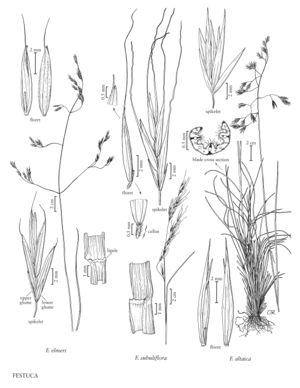Festuca elmeri
Plants loosely cespitose. Culms 40-100 (120) cm, glabrous, erect or slightly decumbent at the base. Sheaths closed for less than 1/3 their length, glabrous, smooth or slightly scabrous, shredding into fibers; collars glabrous, smooth or slightly scabrous; ligules 0.1-0.5 (0.7) mm; blades 1.8-6 mm wide, vegetative shoot blades narrower than the cauline blades, flat or loosely conduplicate or convolute, abaxial surfaces glabrous, adaxial surfaces slightly scabrous or pubescent, veins 7-19, ribs obscure to prominent; abaxial sclerenchyma in narrow strands; adaxial sclerenchyma developed; pillars or girders present at the major veins. Inflorescences 10-20 cm, open, with 1-2 branches per node; branches lax, more or less spreading, spikelets borne towards the ends of the branches. Spikelets (7) 7.5-11 mm, with 2-6 (7) florets. Glumes lanceolate, glabrous, smooth or the apices slightly scabrous, acuminate; lower glumes 2-4 mm; upper glumes 3-4.6 mm; calluses wider than long, smooth or slightly scabrous, glabrous; lemmas 5.5-7 mm, lanceolate, scabrous or puberulent, minutely bidentate, awned, awns (1.5) 2-5 (8) mm, subterminal, straight to slightly curved or kinked; paleas as long as or longer than the lemmas, intercostal region puberulent distally; anthers (3) 3.4-4 mm; ovary apices pubescent. 2n = 28.
Discussion
Festuca eltneri grows on moist wooded slopes, usually below 300(500) m, from Oregon to south-central California. The more southerly populations, which have larger spikelets with 5-6, rather than 3-4, florets and a more compact inflorescence with more or less erect panicle branches, have been named F. elmeri subsp. luxurians Piper.
Selected References
None.
Lower Taxa
"wider than long" is not a number."decumbent" is not a number."longest" is not a number.
